All I did was try not to think. Instead, I was focused on my breathing. Inhale. Exhale. Repeat. I knew my body had the movement memorized, as I had done it countless times before the challenge.
I wanted to blast that kettlebell through the Dome and I knew I had to explode once I reached the bottom position of the pistol. I approached the bell, cleaned it, descended to the bottom, and BOOM! I blasted off. Pistol complete.
Know Your Beast Tamer Requirements
When it comes to the Beast Tamer Challenge, here are the StrongFirst rules for the pistol:
- The candidate must be barefoot.
- The candidate may pick up the kettlebell in any manner and hold it in front with two hands by the horns or with one or two hands in the rack on either side.
- The candidate shall raise one leg in front of him. From that moment on, the foot of the working leg must stay planted.
- The airborne leg has to stay in front for the duration of the attempt. It does not have to be straight. It may not touch the ground or the working leg.
- The candidate shall pause motionless long enough to demonstrate balance, then lower himself at least to parallel: “the top surface of the leg at the hip joint lower than the top of the knee.”
- Neither the kettlebell nor the arms may touch the working leg at any time.
- A pause in the bottom position is not required. The candidate shall stand up until the knee of the working leg is locked and the hip is extended.
- The pelvis may not rise faster than the kettlebell.
- The candidate shall stand on one foot exhibiting control until the head referee’s “Down!” command.
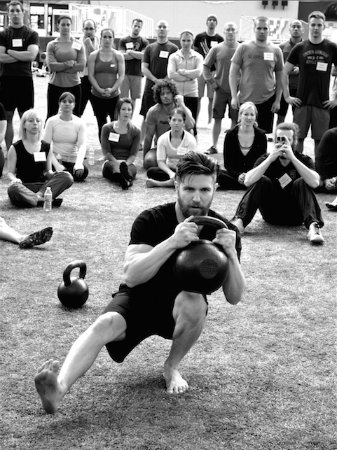 Follow the Principle of Specificity for Beast Tamer Training
Follow the Principle of Specificity for Beast Tamer Training
I want to point out one very important training principle you must adhere to if you have a goal you intend to reach. The training principle is referred to as the Principle of Specificity. Put simply, it means if you want to become better at a skill or exercise, then you must perform that skill or exercise.
So if you want to be a Beast Tamer, then your training should primarily consist of the pistol, military press, and pull-up. All you need to do is one repetition for each exercise, so your training should consist primarily of single repetitions. Your program should also involve periodization of load, intensity, and volume in order to force an adaptation (i.e. get stronger).
The moral of the story is not to get too crazy with your training. Keep it basic and simple. These are two of the most important training tips I can give you for any training that you will ever do.
Technique Tips to Help With Your Beast Tamer Pistol
As you can tell, the pistol requires mobility of the ankles, knees, and hips. Other than mobility and strength, balance is probably the most important physical skill required to complete a pistol. I referenced mental imagery in part one of this series. You will want to use your mental imagery before beginning any major lift. Just do a replay of you performing the exercise in your mind.
I recommend holding the kettlebell with both hands in the goblet position as it allows for the most balance since it’s centered and you also have both hands instead of one to hold the bell. Once you’ve got the the kettlebell in the goblet position, you will want to do a static stomp with the working leg in order to generate tension and balance you out.
Breathing is critical. You need to focus on your inhalation and exhalation timing, as well as the tempo. I would always static stomp, lift the non-working leg, and do a short inhalation and exhalation to ensure my balance.
Next I would do a tempo-based deep inhalation in my descent to the bottom, while simultaneously generating as much hamstring and glute tension as possible all the way down. This generation of tension will keep the movement balanced and controlled. Your inhalation should end once you reach bottom position and everything should be extremely tight because you have generated as much tension as possible similar to a “coiled spring,” as Master SFG David Whitley likes to put it.
During your descent, it is also important to keep the kettlebell tight to you in the goblet position. If the kettlebell gets away from you, then it could compromise your pistol by off balancing you, which could also get you disqualified if it touches your leg. What should you be doing with the non-working leg? I recommend keeping the leg straight and toes flexed. You don’t want this leg moving as it could also jeopardize your balance.
The last part is the ascent, which should be initiated with a tempo-based exhalation, simultaneous heel drive, and firing of the quadriceps. You want to explode or uncoil the spring by releasing all the tension you have generated in one forceful motion.
One of the hardest parts of this movement is the transition from the eccentric to the concentric motion. Just make sure you are tight at the bottom, and that you concentrate, putting all your focus and attention into the change of direction. Oh, and be sure to lock out the hips at the top.
GET STRONGER AT THE SFG CERTIFICATION
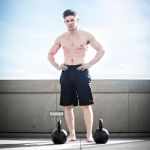
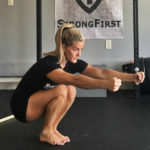
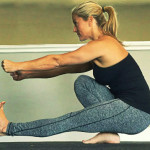
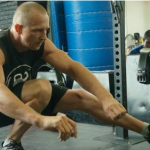


Hi Kenton, I read this when you first posted it (part 1 too). Are the remaining parts in the works? I too have Beast Tamer aspirations and would love to read more about your experience.